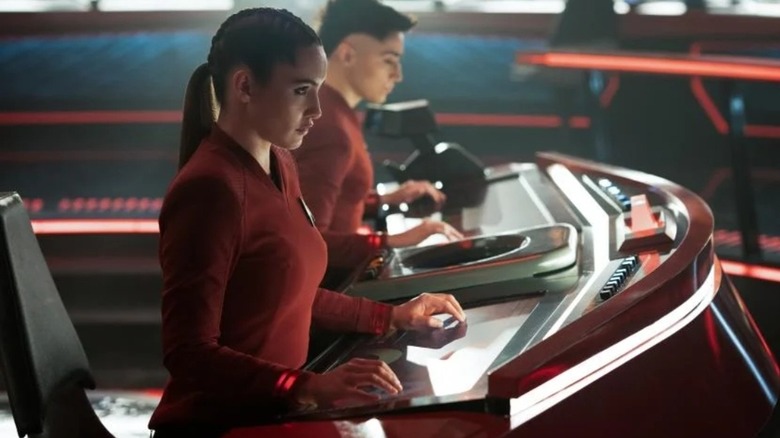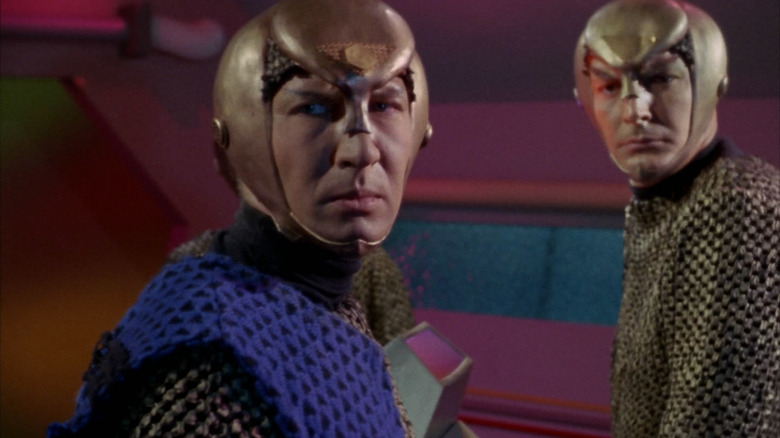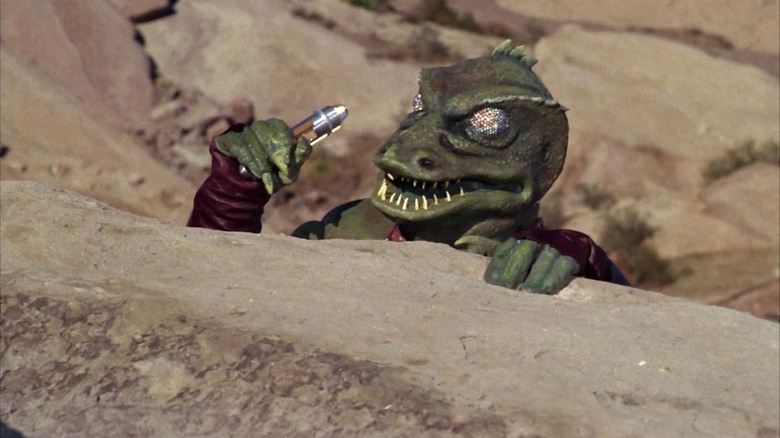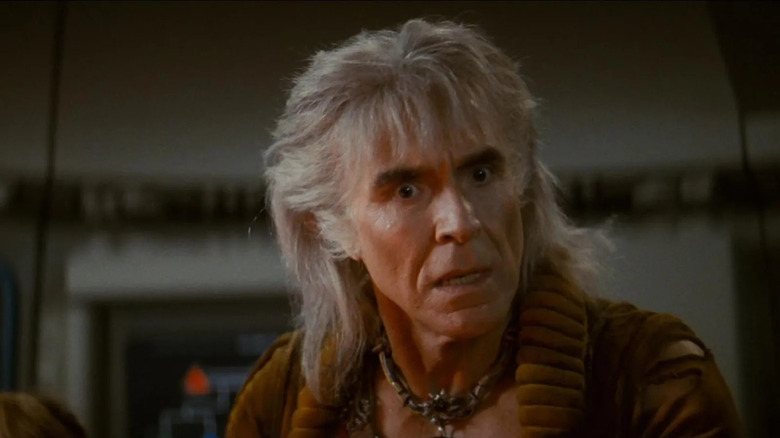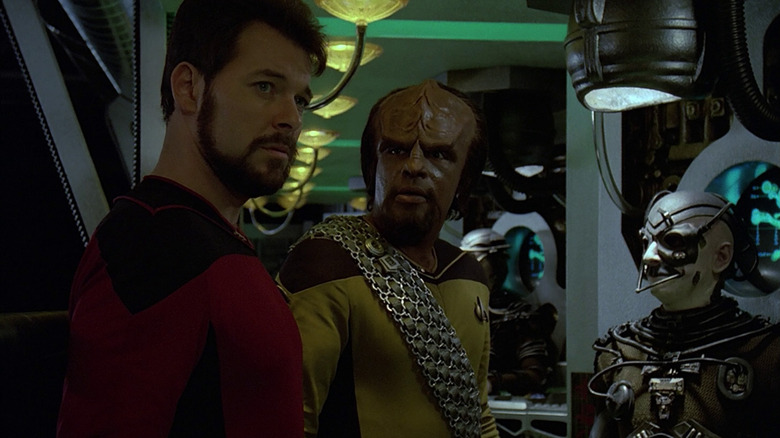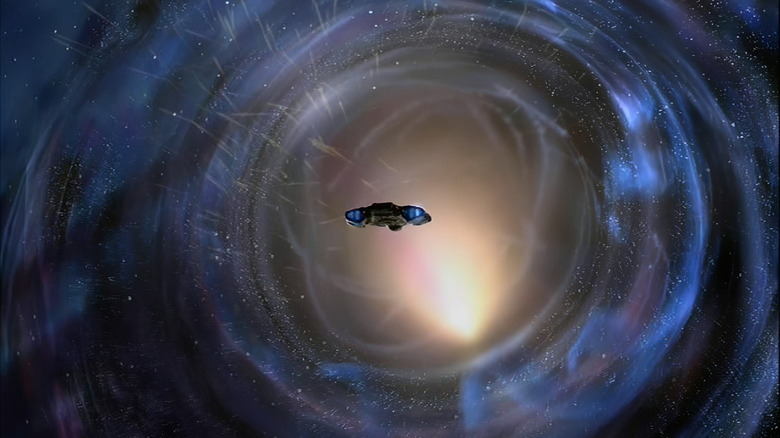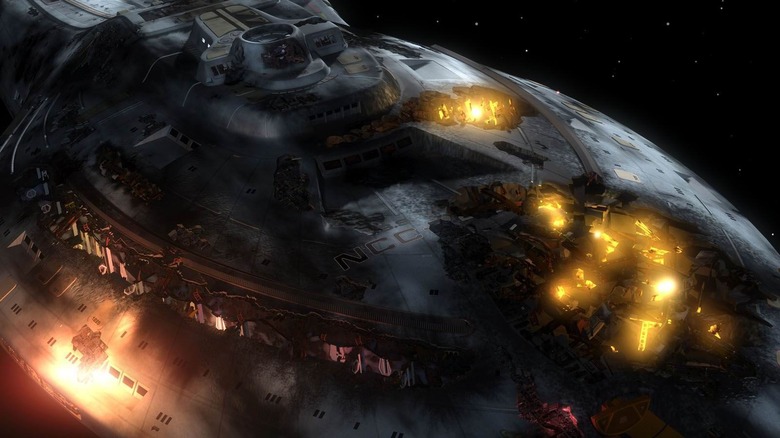The Classic Star Trek Episodes That Inspired Strange New Worlds Episode 4
This post contains minor spoilers for episode 4 of "Star Trek: Strange New Worlds."
The Latin phrase "memento mori," often seen on tombstones, is intended as a grave, humbling reminder. The translation is simply "remember that you will die." The fourth episode of "Star Trek: Strange New Worlds" is called "Memento Mori" and, if I may begin this article with a personal preference, I love when "Trek" skews classical. The franchise often references ancient poetry, Latin axioms, and Shakespeare, revealing a delightfully welcome lit-nerdy bent to the shows that is often absent from many of its sci-fi contemporaries. The writers of "Trek" are well-read, and it shows.
While "Star Trek" gains most of its narrative traction in remembering it is a workplace drama, it would do well to recall that it is — at least in the case of the 1966 original — a naval show. Starfleet uses naval ranks, and the 1966 Enterprise resembled a sci-fi TV version of a submarine. As such, naval-style battles would crop up from time to time (only in extreme situations; Starfleet would rarely pick a fight) wherein two ships would face off, not communicating, attempting to alternately do damage and flee the other (fast-moving starship dogfights have sometimes happened throughout Trek, but that type of battle is far more the purview of "Star Wars").
This is the center concept of "Memento Mori," an episode wherein the Enterprise faces off against a mysterious ship belonging to the Gorn, a species as yet unseen at this point in "Trek" history ("Strange New Worlds" is set prior to the 1966 series). Looking back over Trek, we'll find several instances of precedent, each of which feel like they could've inspired this latest episode.
Balance of Terror
The ninth episode of "Star Trek," (or 14th, if you prefer the utterly incorrect broadcast order) was called "Balance of Terror" (original air date, December 15, 1966) and it was the first episode to deal with the then-mysterious Romulans, a hostile species who are able to cloak their ships, making them undetectable to the Enterprise's scanners. The Romulans would play a large part in "Next Generation," as well as "Nemesis" and the 2009 J.J. Abrams reboot film. It is in "Balance of Terror" that we learn of the Earth-Romulan War from years previous that led to the creation of a Neutral Zone on the border of Romulan- and Federation-run space. If either species ventures into the Neutral Zone, it is considered an act of hostility.
"Balance of Terror" largely focuses on a scrape between the Enterprise and a single Romulan ship, led by an unnamed commander played by actor Mark Lenard (who would go on to play Spock's father Sarek in multiple "Trek" episodes and films). Unlike "Memento Mori," a lot of time is devoted to the reasoning of the Romulan Commander and how he responds to Kirk's defense tactics. The Romulan Commander will plant a nuclear bomb inside some garbage, cleverly disguising his weapon. Luckily, the Enterprise sees it in time and blows it up.
After the battle is won, Kirk (William Shatner) and the Commander finally have one conversation, their first. They admit to a mutual respect, and even suggest they might have been friends in another life. "Balance of Terror" is surprisingly militant for a franchise that would eventually be known for its pacifism, but it's a thrilling corker and a well-made naval battle that shouldn't be missed.
Arena
The attacking ship in "Memento Mori" belongs to a species called the Gorn, well known to the Enterprise's security chief La'an (Christina Chong) and to no one else. The Gorn first appeared in the notorious "Star Trek" episode "Arena" (January 19, 1967) wherein Kirk and an unnamed Gorn captain (Garry Combs and Bobby Clark, voice of Ted Cassidy) were forced by a mysterious angelic figure to do battle to the death, using only what weapons they could find growing natively at Vasquez Rocks in California. Or rather, an alien planet that happens to look an awful lot like Vasquez Rocks in California.
The Gorn are two things at once: A mysterious, monstrous threat from a terrifying race of reptiles ... but also high camp. The unmoving Gorn mask and embarrassing fight choreography of "Arena" are revisited by Trekkies for their kitsch value more than their thrills. The Gorn did reappear in an episode of "Enterprise," and were — perhaps in keeping with the bad mask tradition established in 1967 — realized with some pretty awful CGI.
"Strange New World" is the first filmed "Trek" outing (the Gorn naturally appeared in several Trek tie-in novels) that makes the Gorn seem overwhelming and threatening. La'an explains a traumatic experience she had with the Gorn several years prior when they attacked her entire colony ship, ate some of its denizens alive, and used human bodies as "breeding sacs." That's far scarier than the choking session that Kirk went through.
Wrath of Khan and Nemesis
For many, the high point of all "Star Trek" came with the 1982 release of "Star Trek II: The Wrath of Khan." The film, a sequel to the episode "Space Seed" (February 16, 1967), sees the return of Khan (Ricardo Montalbán), an embittered, genetically enhanced supersoldier who had been left on an uninhabited planet that, unbeknownst to Kirk, would fall victim to a galactic cataclysm, turning it into an uninhabitable desert world. Khan escapes, hijacks a starship, and goes looking for Kirk, thirsting for revenge. "Khan" is such an exhilarating watch, that it — a "Trek" purist might argue — bent the franchise for the worse; The "bad guy out for revenge" plot would become the basis for multiple feature films to follow.
The climax of "Khan" is a slow-moving submarine-style battle wherein the Enterprise and Khan's ship, the Reliant — unable to see one another — stalk around inside a nebula, only firing when their positions are arranged just so, doing massive damage to each blow. One might say the battle in "Khan" is an antidote to the spatial fast-flying of "Star Wars."
This climax would be mirrored, nearly exactly, in the 2002 film "Star Trek: Nemesis," wherein the Enterprise-E would face off against a revenge-bent villain named Shinzon (Tom Hardy). The battle would take place in a nebula, with each ship being weakened by each choice attack, eventually leading to both ships crashing into one another. It would be exciting, if it weren't so derivative. It is still one of the more notable ship-to-ship battles of the NextGen era of "Trek."
Q Who
A highlight of "Star Trek: The Next Generation" is the episode "Q Who," which would mark the first appearance of The Borg. While The Borg would go on to be the basis of a complex mythology of their own (they would reappear several times on "Next Generation," form the basis of one feature film, and occupy a sizeable percentage of "Star Trek: Voyager"), their first appearance was a mysterious and threatening experience for the Enterprise-D, leading to one of the more destructive face-offs in the show's history.
In the episode (first aired on May 8, 1989), the trickster god Q (John de Lancie) hurls the Enterprise into deep space where the crew encounters a mysterious species of soulless cyborgs who seek to absorb the technology of others. The Borg travel in an enormous cube-shaped ship that can seemingly regenerate itself, has no commander, and is staffed by people who have been assimilated into its collective. The bulk of "Q Who" is devoted to investigating this mysterious ship, and attempting to flee from it. The Borg, of course, easily outmatch the Enterprise. It's not until Picard (Patrick Stewart) admits he needs Q's help that they are saved.
The Enterprise unleashes weapons on the Borg ship, but the Borg don't seem to notice, and even slice a cylindrical tube from the Enterprise's saucer section. A mysterious face-off where the Enterprise is grievously damaged — "Trek" at its finest.
Sacrifice of Angels
The latter seasons of "Star Trek: Deep Space Nine" took place during a massive, multi-army war between the Federation and the Dominion, a fascistic, militant organization of conquerors from the other side of the galaxy. While war had previously been anathema to "Trek" — recall, devoted to pacifism — "Deep Space Nine" argued that there will be limits to Starfleet's peaceful ethos, especially when it comes to those devoted to power and domination. The Dominion War was never depicted as a positive experience, however, and hard-won battles were always tragic and left scars. There was war, but "DS9" was careful to assure no one felt good about it.
In one of the more exhilarating climaxes on DS9, "Sacrifice of Angels" (November 3, 1997) came at the end of a six-episode arc wherein the titular station had been taken over by Dominion forces, mines had been places around the edge of the wormhole that would provide backup, and the station's defenses had been sabotaged by Rom (Max Grodénchik), allowing Captain Sisko (Avery Brooks) to pilot his attack ship the Defiant through. The episode is a multi-pronged action episode where, not to put too fine a point on it, a lot of s*** goes down. Delving into each character's arc would take far too much time.
"Deep Space Nine" is a far more aggressive show than any of the other "Trek" programs ("Discovery" and "Picard" notwithstanding), so it makes sense their "battle" episode should have far more action and incident than its counterparts.
Year of Hell
The U.S.S. Voyager received no end of damage in the two-part episode "Year of Hell" (November 5 and 12, 1997). Facing off against a time-warping villain (Kurtwood Smith), Captain Janeway (Kate Mulgrew) would find her ship at the mercy of the Krenim Imperium, an aggressive species of battle-happy bad guys who wouldn't let up on their attacks for, well, a whole year. The crew is desperate, injured, damaged, blinded, kidnapped, or killed. It's a bad time all around.
"Year of Hell" deals with a timeline-altering device that can alter the nature of causality and bring alternate universes into being (it was being used to restore the existence of Smith's dead wife), so savvy Trekkies knew that whatever damage done would eventually be undone. But that didn't change the shock of seeing Tuvok (Tim Russ) blinded, or Chakotay (Robert Beltran) taken hostage. It is weirdly refreshing to occasionally see "Star Trek" take its gloves off and present the crew with a villain that cannot be reasoned with. But then, that's the shared theme of the episodes on this very list.
Originally, "Year of Hell" was meant to be a full season of "Voyager," but executive producer Rick Berman preferred — rightly or wrongly — serialized storytelling over arc-heavy plots. And while Berman didn't always make the best decisions, a certain kind of Trekkie can appreciate his adherence to classic "Trek" structure.
That classic structure has been restored for "Strange New Worlds," a show that — like "Lower Decks" — returns the franchise back to problem-solved-by-the-end-of-the-hour, Bermanian "Trek." "Strange New Worlds" is doing everything in its power to produce a slick, exciting show that continues the tone and structure of the long-running franchise ... and it's succeeding.
